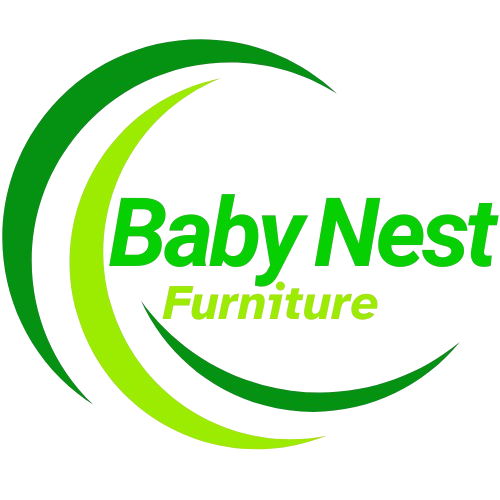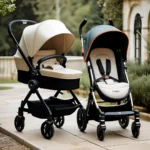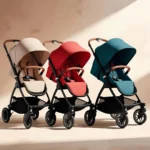One of parents’ most significant decisions is selecting a crib for their baby. In addition to sleeping, a crib has other uses. It becomes the focal point of their nursery and is also one of the top items on other mothers’ wish lists, as most families invest quite a bit in their children’s bedding! Choosing between wood and metal cribs can be challenging due to the abundance of available options. In this blog post, we’ll explore both materials’ differences, benefits, and drawbacks, helping you make an informed decision. So, which one is best for your baby?
Why Crib Material Matters: Safety, Durability, and Design
To compare wood vs. metal cribs, let me explain how crib material makes a difference. A crib may offer your baby a secure, restful area to sleep, and the material utilized in inclusion will determine its durability, how easily it is usually maintained, and whether or not the overall appearance of this dormir will go with other home furniture. Whether traditional or modern, you will benefit exclusively from wood and metal.
Solid Wood Cribs; The Classic Solid wood Crib (Durable, Timeless)

Pros of Wood Cribs
1. Safety and Durability
Sterling offers natural wooden cribs for parents. Sturdy wooden cribs: High-quality wood, such as oak (pediatricians often recommend this type for good air circulation), maple, or birch, will last many years. Their natural material strength makes them a good option for active toddlers who may turn their crib into a playpen. **Safety**: Most wooden cribs comply with applicable safety standards and go beyond the requirements to help protect your little one while asleep.
2. Aesthetic Appeal
Appearance This is one of the most apparent advantages of a wooden crib. The woodwork trims cribs from rustic and traditional to smooth and modern designs. Wood has natural grains that add warmth and character to any nursery. A wood crib will fit right into a cozy, classic nursery.
3. Eco-Friendly Option
Most of the wood cribs used to make these types of baby bed cribs for your toddlers have been taken from sustainable and renewable resources. As a result, we can say this is an eco-friendly option, too. Selecting a crib of environmentally friendly wood reduces your environmental impact on the world if you are concerned with how products affect our Earth.
4. Customization and Versatility
Customization in wooden cribs is very high. They can be finished in walnut, mahogany, or natural wood finishes. Moreover, a wooden crib can often adjust into a toddler bed or be converted to a full-size bed when your baby outgrows the first purpose.
5. Quiet and Sturdy
Wood is quieter than metal in nursery furniture, as wood absorbs noise and vibrations better. This could lead to fewer distractions from your baby while sleeping.
Disadvantages of Wood Cribs
1. Weight and Mobility
Wooden cribs may be more cumbersome than metal cribs, making it difficult to move them around the room. However, this could be an issue if you plan to have easy mobility around your nursery or a crib that can be quickly moved from place to place.
2. Potential for Warping
As time passes, wood can warp or crack easily, especially in damp settings. Even the best wood cribs are finished to be resistant to moisture and can withstand the effects of temperature fluctuations in your home.
3. Cost
Some wooden cribs, particularly those constructed of solid hardwoods, will be pricier than metal options. If you have limited money, finding a solid wood crib within your pocket’s reach may be tricky.
Best Metal Cribs for Modern, Sleek Look and Heavy-duty Lasting.

The Advantages of Metal Cribs
1. Strength and Longevity
Metal cribs are super sturdy and may be passed down to the next generation. The durability of the metal cage is helpful if you plan to pass it down as an heirloom for future children or family members. Metals Crib: Made from supplies such as steel or iron, metal cribs are almost unbreakable.
2. Easy Maintenance
Metal cribs are also extremely easy to clean. They do not need as much attention and can be cleaned with a damp cloth. Metal does not warp like wood from absorbing moisture.
3. Sleek and Modern Design
Parents who seek a modern nursery look can get this; it provides a meta, clean, and essential vibe. And since Ninio clocks are available in matte black, white, or brushed gold finishes, they would add elegance and finish to any room home for your new little one.
4. Safety Features
Metal cribs of today have to pass safety requirements and are created with curved edges that lessen the possibilities for injuries. They are strong and sturdy, perfect for those busy babies/toddlers.
Cons of Metal Cribs
1. Cold to the Touch
This can be a downside, especially when the crib is made of metal since they tend to get cold in colder areas. Parents who are firmly against metal cribs will tell you they aren’t as welcoming and cozy as wood.
2. Heavier more tough to transport
Though metal cribs can be stronger, they are also usually heavier than wooden cribs. This makes them harder to put together and move around, which might be an issue if you like changing the room configuration in your nursery.
3. Noise
Metal cribs have the advantage of being noisy over time, especially when moving your baby or adjusting its height. Then you can give a gentle sleepy phrase to help your baby save the sleeping, which is crucial if they are someone who wakes up at every peep.
Wood vs. Metal Cribs: Which One Is Best for Your Baby?
So now that we know the pros and cons of wood vs. metal cribs, you might still be left wondering which one is best for your baby. It comes down to your taste, what you can afford, and the overall design of your nursery.
- Wood crib: Offers a classic, warm, and cozy look with the promise of durability. * If you are all about being able to work year-round, consider this option! Wood cribs have a look that can be maintained as natural, making them easy to change for different nursery themes, and they are incredibly sturdy, so you can often use the same wood crib through part or all of your family.
- Metal Cribs: Conversely, if you prefer a stylish setting that possesses modern undertones and does not require to be fussed over in the long run, then metal cribs are more what you want. Metal Cribs One of the best things about metal cribs is their durability and longevity, meaning you buy it once (that meets safety standards) and use it again for a second or third child.
Either way, be sure the crib complies with current safety regulations so that you pick a crib which is safe for your baby to sleep.
Crib Material Comparison — Wood Vs. Metal
Feature | Wood Cribs | Metal Cribs |
Aesthetic Appeal | Classic, warm, and customizable | Modern, sleek, and minimalist |
Durability | Highly durable but can warp over time | Extremely durable, can last for generations |
Safety | Meets safety standards, softer materials | Meets safety standards, very strong |
Maintenance | Requires regular care and maintenance | Easy to clean and maintain |
Cost | Higher cost for high-quality wood | More affordable option |
Noise | Quiet and absorbs sound | Can be noisier when baby moves |
Mobility | Heavier and harder to move | Typically heavier and harder to move |
Customization | Highly customizable with various finishes | Fewer customization options |
Tips on how to make the Sabbatical for your baby
One thing to remember for whether a wood vs. metal crib is appropriate depends on your baby’s needs, as well as what look you like and how much money you’re willing to spend. One is not inherently better than the other; they have pros and cons for safe sleep, which you’ll need to weigh carefully when deciding how your little one will slumber. In the end, what is right for your baby according to you, that’s how you pick into this.
It hardly matters whether you buy a shelter or a modern metal wire crib because, ultimately, the most important thing is ensuring that your child sleeps safely and peacefully next time. Remember to consider how long the crib will last, its maintainability, and how much you like its appearance when making your choice. Quality is essential, no matter how you go; a good crib will contribute to many nights of home security.










Leave Your Comment: